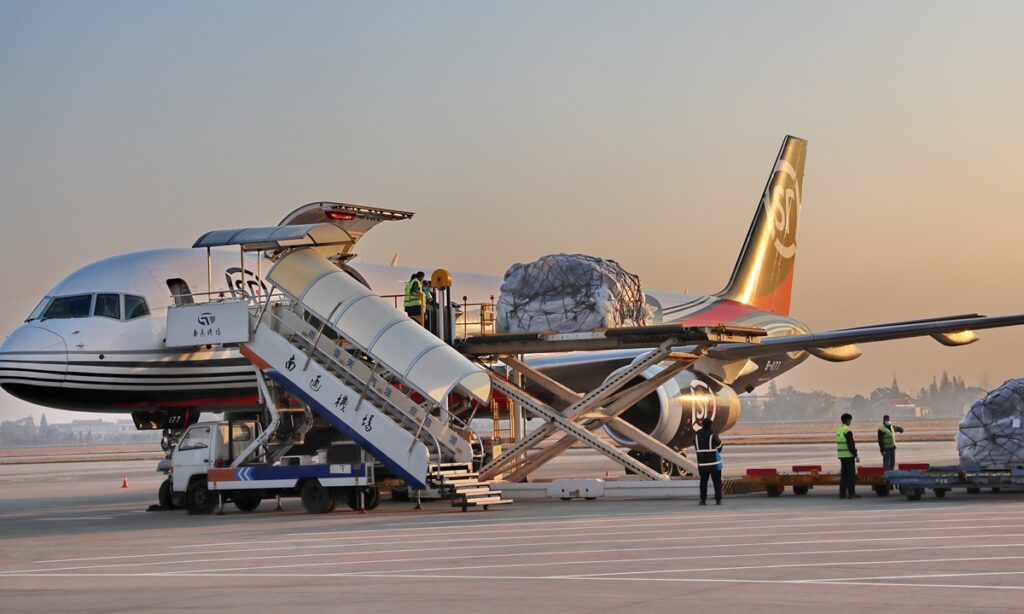Despite the slow recovery of the Asia-Pacific aviation industry, many international cargo giants are still continuing to bet on China’s air cargo market, with rising demand showing no sign of slowing.
Boeing Tuesday announced at the Singapore Airshow that it will add a 767-300 Boeing Converted Freighter (BCF) conversion line at ST Engineering’s airframe facility in Guangzhou, South China’s Guangdong Province in the second half of 2022, a move to support growing global customer demand.
The new line adds to the two 767-300BCF additional conversion lines Boeing previously announced at the Guangzhou Aircraft Maintenance Engineering Company Ltd, an existing MRO supplier for 737-800BCF conversions.
Last year, Boeing also announced plans to add eight 737-800BCF conversion lines across new and existing MRO suppliers.
Boeing forecasts a need for 1,720 freighter conversions over the next two decades. Asia-Pacific-based airlines will require 505 large and medium widebody freighters, both new aircraft and conversions, through to year 2040, according to the 2021 Boeing Commercial Market Outlook.
To boost its cargo business, Etihad Cargo, the cargo and logistics division of Etihad Airways Group, has launched an official Chinese website, which will be the landing page for all China based clients. All relevant product information, site capabilities, customer feedback and agreement details will be presented in Chinese.
Experts have attributed the move to rising cargo business demand in China as the country consolidates its role as the engine room for the global recovery.
Despite uncertainties, many companies are still busy filling massive export orders and remain confident about their export prospects this year. Factories across China are gradually resuming production after the Spring Festival holidays, making a bright start to 2022.
Official data showed that the scale of China’s import and export of goods exceeded $6 trillion for the first time in 2021, a record high.
China’s Foreign Ministry said earlier this month that the country’s dynamic and resilient economy has been playing a positive role in stabilizing the global supply chain and promoting the recovery of the global economy.
The official website of Civil Aviation Administration of China (CAAC) said on Tuesday that it has approved 564 chartered international cargo flights in January, reflecting robust demand from around the world.
Market watchers said the rapid recovery of economy, the diversification of manufacturing and supply chains continue to fuel demand for global logistics and transportation. Due to the shortage of labor and one-way demand, container shipping and China-Europe rail links are extremely congested, leading to the global industrial chain and supply chain facing significant pressures, while also funneling excess demand into air freight.
According to data released by the International Air Transport Association (IATA), in 2021, global air cargo demand increased by 6.7 percent compared to 2019, and with the epidemic causing a sharp reduction in belly capacity of medium and long-haul passenger aircraft, available air cargo capacity has dropped by 11.5 percent compared with the same period in 2019.
This extreme imbalance between demand and supply has pushed companies to be more innovative when it comes to air cargo.
East China’s Jiangsu Province saw its local cargo flight sector over the last two years surge by 489.2 percent compared with levels before the COVID-19 epidemic, according to the provincial border inspection department, as reported by Xinhua News Agency in January.
The number of international air cargo flights reached 13,686 in 2020 and 2021, with many passenger aircraft being refitted to perform as cargo carriers due to the epidemic, according to the department.
The Chinese regulator has increased emphasis on the domestic cargo business. Chinese officials said they will implement the development strategy of paying equal attention to both passenger and cargo, which means the industry will change the previous policy orientation of focusing on supporting passenger transport.
Due to the low cost and wide accessibility of cargo in the belly of passenger aircraft, the development of aviation logistics cannot simply pursue the increase in the number of all-cargo aircraft, and the belly cabin of passenger aircraft is still one of the most realistic options, said Liang Nan, an official from CAAC on Wednesday, citing the 14th Five-Year Plan (2021-25) of civil logistics.
CAAC data also showed that China completed cargo transport equal to 654,000 tons in January, a month-on-month increase of 1.1 percent.
The IATA released data for global air freight markets showing that full-year demand for air cargo to increase by 6.9 percent in 2022, adding demand for goods manufactured in the Asia-Pacific airlines remains strong, including PPE.
A Boeing 757 freighter loaded with cargo by SF Airlines arrives at Nantong airport in East China’s Jiangsu Province. Photo: CFP




